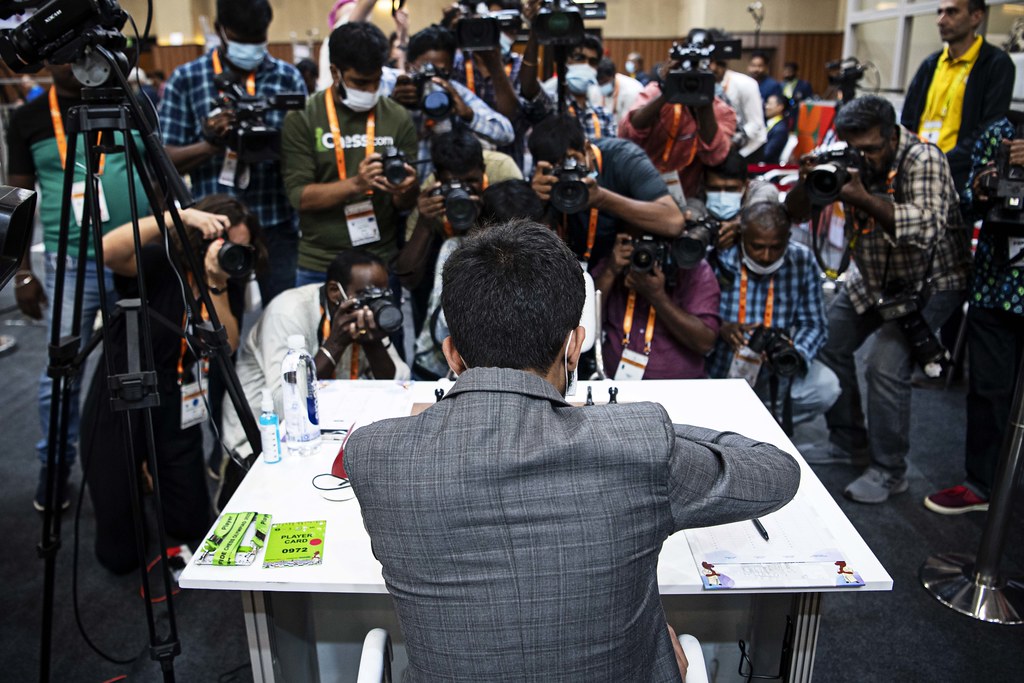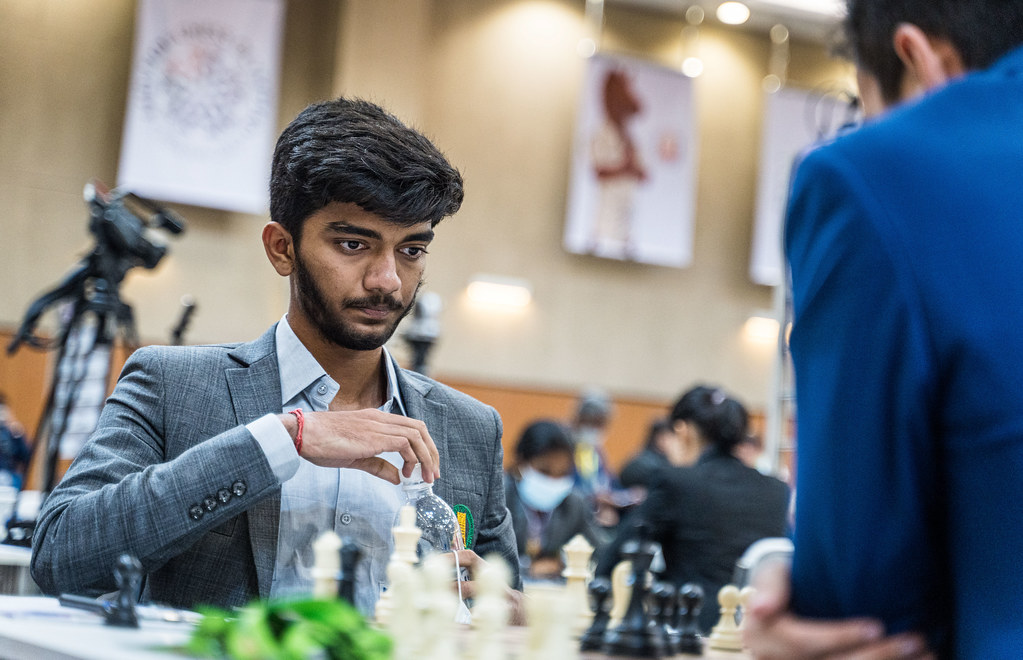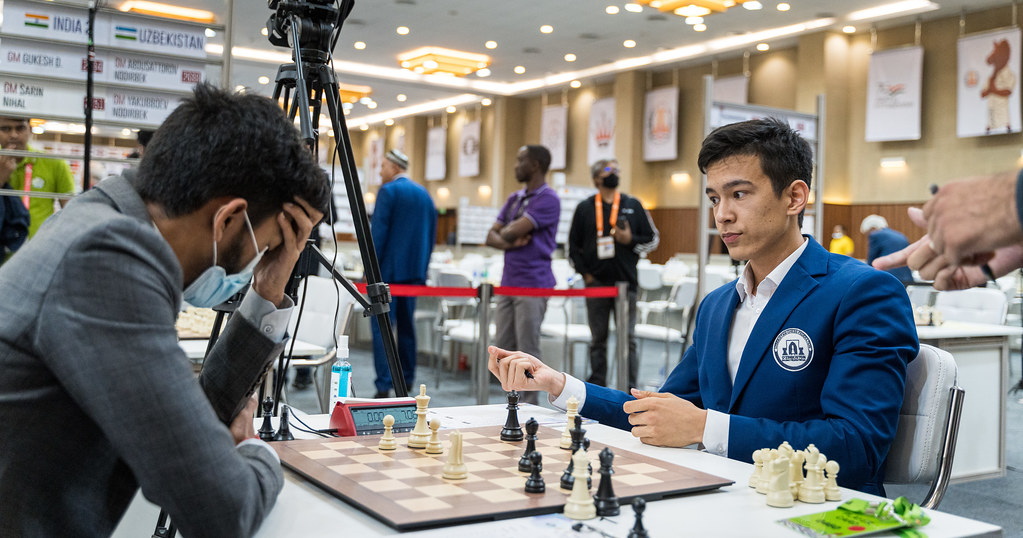


Chennai. The tenth round saw the battle of the two teams that shocked the chess world during the 44th edition of the Olympiad. The youngsters of India 2 finally faced Uzbekistan. The Uzbeks were ahead by one match point at this stage. It was clear that this match was crucial in the fight for first place in the open section.
At first, things went very well for the Indians, who achieved two draws with Black. Shortly before the time control, it was clear that Praggnanandhaa would win his game against Javokhir Sindarov. On the first board, the two outstanding representatives of each team were battling it out. Gukesh for India and Nodirbek Abdusattorov for Uzbekistan.
The tension of the contenders in the key game of the round was best captured in a video summary published by ChessBase India.
The course of the match is simply told: Gukesh had yet another excellent day. Nodirbek was in the back foot, and after 32 moves it looked like a clear win for India. Gukesh's exemplary game management had led to the following position.
The pawn on c5 is lost, and White's only task is to prevent the opponent’s queen from invading his camp. Gukesh can capture the pawn here, but his f2-f3 push is also perfectly suitable.
The Uzbek has little to do, moves his queen to d6 and sets his sights on the g3 square. After this move, the Indian can capture on c5 with the knight, attack the bishop and move back to d3 with the minor piece. It cannot be long before India celebrates another win, one thinks.
Gukesh plays his king to f1, presumably to deal with a potential penetration on his own first rank by later placing his monarch on e1 or e2. He plans to only then take on c5 with the knight — or, with the king on e2, to capture with the queen on c5. This method seems somewhat awkward, but should also work.
The time control has been reached. White is clearly winning. The Uzbek had briefly placed his bishop on f5, and Gukesh exchanged the a-pawn for his opponent’s e-pawn.
But for the first time a threat interferes with white’s plan. If it were Black’s move here, he would give a check on g1. Gukesh fends off his opponent’s supposed threat and continues to work on exploiting his advantage. Nevertheless, as an experienced player, one suspects that in the long run the white king needs a safe hiding place to avoid bothersome checks.
After the knight moves to c5 and the black queen goes to a5, Gukesh responds by placing his king on d1. For the first time, as an observer, one gets small doubts about a second win today for India. The king would be safer on h2 and would defend his pawn on g2.
But Gukesh is a good calculator, and most likely knows what he is doing, the doubting observers are reassured.
Only the vulnerability of the white king gives Black some hope. But the white king is positioned on c2, preventing the black queen from invading along the d-file.
Things are going well.
Gukesh’s next move surprises, amazes, frightens the spectator. It is the first move without a recognizable, comprehensible justification in this game, probably in this tournament. The Indian moves his king to b2. Wasn’t this king better on c2? Teammate Praggnanandhaa on the next board obviously knows the proper technique to convert his endgame with rook and h-pawn against bishop, so a draw would nonetheless give India match victory. Calming pills.
A few moves later, this is how the situation on the board looks.
The black queen has invaded on g1. White can move his queen to c2 again here, and Nodirbek probably has no choice but to ask the opponent — by moving his queen to c5 and then to d2 — whether he intends to play on after returning to g1.
If he likes, Gukesh and thus India can report a small success. In any case, the threatened repetition of the position would be a safe test that costs nothing. Gukesh does not even try, as moves his king to c2. That is typical for the young generation, but worthy of criticism. Peter Svidler does not understand it, and the Indian fans feel impatient.
Gukesh will say a day later that his decision was irresponsible. In fact, this is the tipping moment of this game which may have cost India the gold medal, though one may argue against this in retrospect — but it feels so.
Vishy Anand explains the situation in detail in his daily Chess Olympiad column in The Hindu. Encouragingly, he writes that this has happened to him many times. He, Anand, had hoped for the draw.
Gukesh rejected the potential draw and is quickly countered by the reigning rapid chess world champion from Uzbekistan. A sudden blunder is swiftly punished and this puts an end to the game. This phase of the game is captured in another video, this time with a view of the clock and board. Many photos are taken of the unfortunate accident for the young Indian.

A much-anticipated confrontation | Photo: Stev Bonhage

Photo: Stev Bonhage

Photo: Lennart Ootes

Gukesh’s blunder | Photo: Lennart Ootes

Time is up | Photo: Lennart Ootes
The photos capture a situation typical of chess: a player makes a gross mistake, and you don’t know how to react, either as the person who blundered or as the one who got lucky.
Gukesh collapses, lets his thinking time run out, and remains sitting in consternation. The Uzbek is also visibly shocked by the situation, presumably empathizing with his opponent for a brief moment. Only his team captain can put a smile on his face.
Such situations happen in chess, often. Rarely, however, are the stakes as high as they were here. For those involved, the intensity of the emotion can probably only be compared to a World Championship match or a final round in a Candidates Tournament.
| Advertising |